SEO Best Practices: The Definitive List for eCommerce in Google Search 


44% of people start their online shopping journey with a search engine.
Let that sink in for a second.
Almost half of ALL people who are shopping online discover brands and products using a website like Google or Bing.
That means that if you’re an eCommerce store, your business literally depends on your visibility in search results.
This guide contains everything that you need to know to improve your visibility in search engine results pages and ensure your audience can discover you online.
Understanding where eCommerce content can appear in Google
Before we jump into Google’s recommendations, it’s important to understand exactly where your brand and products can be featured.
There are multiple spots where your eCommerce content can appear, from search results to Google Shopping and Google Maps. The key is to know what’s available to eCommerce websites and what their search appearance looks like. This way, you can use your eCommerce SEO strategy to maximise visibility across the placements that are most relevant to your product and audience.
Google Search
Every time a customer runs a search for a shopping-related query, Google will display relevant products along with the store name, rating, price, stock level, and description (provided you have the correct structured data markup).
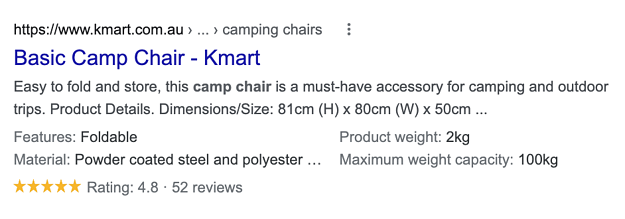
Google Images
eCommerce products can also show up in Google Image Search. With the right structured data, your image may also display additional information once users click into it, such as the price, availability, product description, and link to your shopfront.
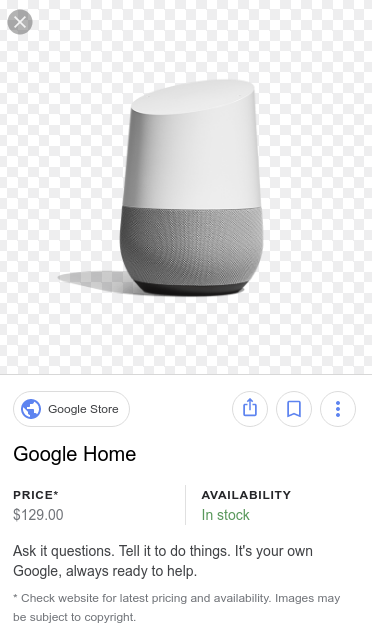
Google Lens
Google Lens is an AI-powered image recognition technology that allows users to search their surroundings by scanning objects, text, and more. If your products are uploaded to the Google Merchant Centre, they’ll be eligible to appear every time someone uses Google Lens to scan and search for your product.

Google Shopping
Google Shopping is another great way to get your products in front of shoppers in search engine results. Using Google Shopping, users can run a search for a specific product keyword, such as “candles”, and browse items from merchants across the web.
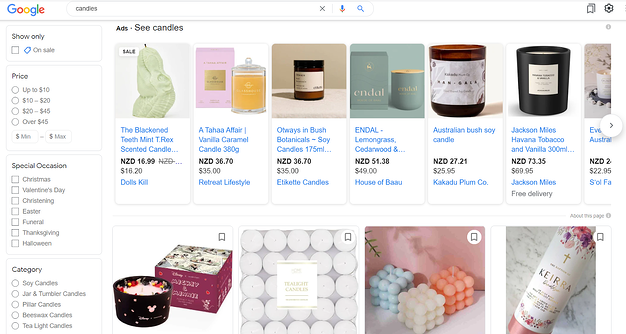
Google My Business
On top of displaying your products to shoppers via Google search, you can also display business and product information through Google My Business. This is particularly useful if you’re operating a physical store as well as selling online.
Google My Business listings even have a spot for you to promote your products and provide links to direct customers to different product categories, like so:
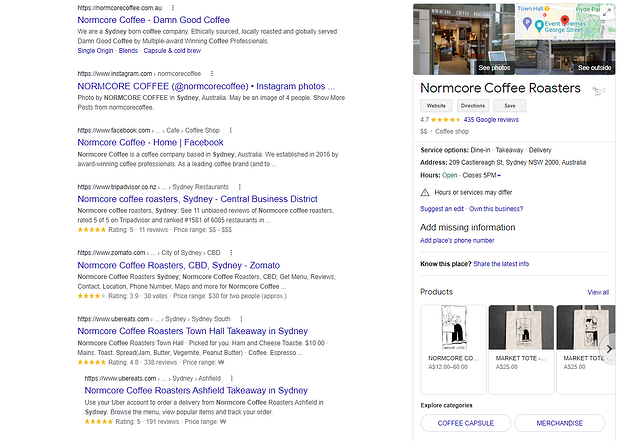
Google Maps
Along with your Google My Business listing, sellers can also display products directly in Google Maps. These products appear to local searches under your listing on desktop and mobile:
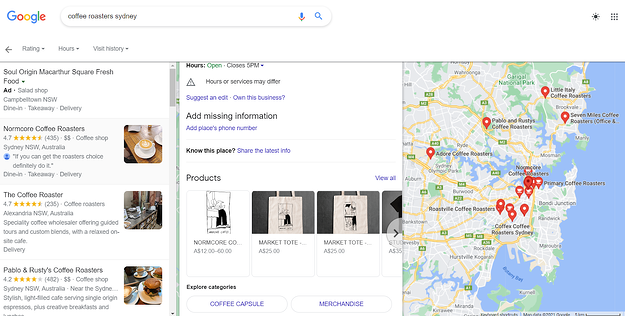
How to share your product data with Google
In order for your products to be eligible to appear in search results and other places, you first need to tell Google what you’re selling. You can do this in two ways:
- Including structured data on your product pages
- Uploading your product feed directly into Google Merchant Center, one of Google’s eCommerce SEO tools
While you can technically pick one or the other, Google recommends that eCommerce businesses do both. This way, you’ll increase your chances of appearing as a rich result AND maximise the amount of traffic you bring to your website.
Mark up your eCommerce website with structured data
Structured data is a way of marking up your website content so that search engines can return more informative and detailed results to searchers. Structured data helps Google go beyond the information on your eCommerce site and actually understand what the data means, as well as the best way to display it in SERPs.
While this type of mark-up isn’t unique to eCommerce websites, there are a few types of structured data that every online business should be taking advantage of:
- LocalBusiness: Display information that’s relevant to your business, such as your location and opening hours.
- Product: Help Google provide detailed product information as a rich result in Google Search and Google Images, including price, stock, review ratings, and product descriptions.
- Review: Allow Google to understand and pull relevant product reviews directly from your website to feature in search results.
- HowTo: Display ‘how to’ guides for your products as a rich snippet in search results.
- FAQPage: Provide Google with the answers to frequently asked questions from potential customers. Like HowTo, FAQPage data appears as a rich snippet in search results.
- BreadcrumbList: Assist Google in understanding the hierarchy of pages on your website.
- WebSite: Help Google understand how site search is implemented on your eCommerce store.
- VideoObject: Allow Google to present videos directly in SERPs for relevant product queries, such as a how to video or promo clip.
You can implement structured data by working directly with your developer, or following these steps:
- Go to Google’s Structured Data Markup Helper.
- Pick the type of structured data you want to use, as well as the URL or HTML source of the web page that you want to mark up.
- Select the elements on the page that you want to mark up.
- Once you’re done, click “Create HTML”.
- Add the highlighted snippets into your website HTML code.
- Run Google’s Structured Data Testing Tool to make sure your markup is working correctly.
eCommerce platforms also have apps specifically designed to help stores add in structured data and improve their Shopify SEO or Magento SEO.
Upload your product feed to Google Merchant Center
A product feed helps Google understand more about your products so it can better display information in search engine results. On top of this, uploading your eCommerce site feed opens up additional opportunities for brand visibility and traffic for your target keyword. Your products will be eligible to show up in listings that require a product feed, such as Google Shopping or Google Lens.
There are two ways for eCommerce sites to upload a product feed to Google Merchant Center, depending on how frequently you update your website.
Building product data with an automated feed
For smaller eCommerce sites that don’t need to be updated frequently, the automated feed option is the most straightforward option. This product feed uses schema mark-up and sitemap information to upload product data directly into Google Merchant Center:
- First, create a Merchant Center account. Once you’ve done this, make sure to verify that you’re the site owner and claim your own site URL.
- Mark up your product pages with the correct structured data attributes. At the very minimum, you need to have the [title], [price], [availability], and [image_link] attributes. However, you can also add additional details such as the [gtin], [brand], [mpn], [size], [color], [description], or [condition].
- Check your structured data is implemented correctly using the Rich Results Tool.
- Head into your Merchant Center account and select the “website crawl” feed input method.
- Go to Products > Add products automatically from your website.
- Google Merchant Center will display a preview containing a selection of products on your website. Once you see these, simply click Add Products to include them in your account.
- After your feed is active, you can monitor and manage your product data directly in the Merchant Center.
Upload product data to Google Merchant Center
For larger eCommerce sites or eCommerce sites with a product inventory that changes regularly, it’s best to upload your product feed directly to Google Merchant Center.
While uploading a product feed to Google Merchant Center isn’t necessary to appear in Google searches for your keyword ideas, it does offer a number of benefits over the automated feed method:
- Ensure that Google knows all of the products that you’re selling on your website. While the search engine will crawl and index products on your website, there’s no guarantee that crawlers will find them all. If you don’t upload your products, you run the risk that some of them might not be displayed in SERPs.
- Greater control over updates to inventory, such as stock levels and prices. Every time you update your product feed, your updates will immediately be visible in the Google Merchant Center. Without these, you’ll have no visibility over when Google will crawl your latest inventory. It may display items that are out of stock or list items at the incorrect price, all of which could affect conversion rates and customer satisfaction.
- Share additional data with Google Merchant Center. You can provide Google with additional information that you may not necessarily want to display on your website, such as up-to-the-minute stock levels. When you upload your product feed, you’ll be able to provide additional information to Google without needing to add it to your e-Commerce site.
Google has detailed instructions for creating, uploading and submitting your product feed into Merchant Center.
Best practices for launching a new eCommerce website
Make sure Google can find your store
When you’re building a new eCommerce website, you want your products to be discovered and indexed by Google as quickly as possible. The best way to do this is to register your store with Google so it can find your website as soon as you launch.
Follow these steps to let Google know about your store:
- Verify that you own the website via Google Search Console
- Submit a request to Google to crawl and index your site. You can do this either by using the URL Inspection Tool or by providing Google with a sitemap.
- Check that your eCommerce site is being indexed correctly using the Index Coverage Report.
- Set up your physical business details and claim your business listing with a Google My Business account.
- Sign up for a Google Merchant Center account so you can upload your product feed and appear in Google Shopping results.
Choosing your e-Commerce SEO campaign launch strategy
When you’re building a new eCommerce website, there are a few approaches you can take. You might choose to do a soft launch, launch a portion of your website to the public and Google, or launch everything at the same time.
Each option comes with its own pros and cons, both for your broader business game plan and for your eCommerce SEO. Take time to weigh these up before launching so you can put your store in the best position to succeed from day one.
The Grand Reveal
In this strategy, you keep your entire site inaccessible to customers and Google. Users might need a password to access your website content, which means you can keep a tight lid on everything until you’re ready to launch.
Pros of the Grand Reveal:
- You’ll be able to sync your website with other marketing campaigns to maximise the impact of your launch.
- You’ll be able to test everything and make sure it works before you launch to the public.
- Your content won’t be visible before launch, which might be important to your sales and marketing strategy.
Cons of the Grand Reveal:
- It will take more time for Google to crawl and index your website. This means there’ll be a delay before you appear in Google Search and Google Shopping, which may, in turn, affect your traffic and sales.
Actions to take: Register your site as soon as possible after launching your eCommerce site. This way, you’ll minimise the delay between launch and your website appearing on a search engine like Google.
Homepage Launch
If you want to start driving traffic to your website and building hype ahead of your launch, you might choose to launch your homepage before launching the rest of your store. This homepage could be a “Coming Soon” page with a link to sign up to your newsletter for the latest updates, or a preview of your upcoming products.
Pros of the Homepage Launch:
- You can register your store with Google ahead of your launch as part of your homepage SEO strategy. This means that your page title tag and meta data will be visible in Google Search ahead of your product launch, even if your products aren’t live yet.
- It gives you a place to drive traffic and improve off-page SEO. This is great if you’re running a pre-launch campaign on social media or working with influencers.
- You’ll be able to capture valuable data from potential customers. When you do launch, you’ll already have an existing database of people who have demonstrated an interest in your products and who are more likely to buy.
Cons of the Homepage Launch:
- Detailed product information won’t be visible in Google Search and Google Shopping until your entire website goes live. As a result, users who are searching for your products won’t be able to discover them until your store is launched.
Actions to take: Verify your website ownership as soon as possible. Once your products are available, you can proceed with the other steps to register your store, such as adding your physical store details into Google My Business for local SEO or setting up your Google Merchant Center account.
Launch without product availability
Want to get your online store indexed and maximise your search visibility for the best keywords ASAP? One way to do this is to launch your full eCommerce website but disable any purchasing functionality until you’re ready to ship orders to customers.
In addition to launching your website, you might choose to allow customers to pre-order products or sign up to be notified when your website does launch.
Pros of launching without product availability:
- All of your site content and products can be crawled and indexed by Google, including your meta tags. When you do launch your website, everything will already be visible to shoppers on Google Search and Shopping.
- Customers will be able to browse all of the products you have on offer. They’ll know exactly what they want to purchase when you are ready to launch.
- You’ll be able to build links and drive traffic to specific product web pages. This way, you can start running Google Adwords and social media campaigns to drum up interest ahead of launch.
Cons of launching without product availability:
- You might end up with some unhappy customers if everything seems functional, but they can’t place orders or find broken links. They might flood your customer service with enquiries or even end up going to a competitor’s website instead.
Actions to take: Follow all of the steps above to register your website with Google. When it comes time to upload your product feed to Google Merchant Center, remember to mark up your stock as unavailable for purchase using [excluded_destination]. A final tip: don’t disable your add-to-cart functionality, as it could affect Google’s ability to verify the final price of your product.
Start with a soft launch
A soft launch is a great way to test the waters and get your website indexed ASAP, while also buying time to host an official marketing launch down the line. You might choose to only make a few products available during your soft launch, or opt to push your entire website live but not drive any traffic to your online store.
Pros of a soft launch:
- Google can crawl and index your website as soon as it goes live. When you do choose to launch on a bigger scale, potential customers will already be able to discover your website via organic search.
- It’s the most simple and straightforward method. There’s no need to worry about disabling any functions or not having visibility in Google Search and Shopping as soon as you launch.
- Your site is fully live and functioning. You’ll be able to test your eCommerce store with real customers and gather their feedback, then implement these recommendations before launching to a broader audience.
Cons of a soft launch:
- You’ll need to have everything ready and functional, and you’ll need to be prepared to fulfil orders as they come in. Because of this, a soft launch is far more labour-intensive than simply launching a homepage or putting a website live without product availability.
- There’s a risk of becoming a victim of your own success. If your website gets referenced by someone on social media, you might end up with a flood of orders that you weren’t prepared for.
Actions to take: Verify and register your eCommerce website with Google as soon as it launches. Keep all of this information and your product feed up to date as your website evolves in the weeks and months following your soft launch, particularly if you’re planning to run a large-scale marketing campaign to officially launch your store.
Optimising your eCommerce website URL structure
URL structure forms an important part of your on-page SEO efforts. A well-designed URL structure makes it easier for Google to crawl and index your eCommerce website and product pages. On the flip side, a poor URL structure could lead to content being missed or delays in your website being crawled and indexed.
When it comes to setting up your URLs, keep it simple and consistent. This means:
- Minimising the number of alternative URLs that might return the same content. If you have one product page listed under /product/black-dress and /product?sku=1234, Google won’t be able to distinguish that both URLs are the same until after it’s retrieved the pages. This can lead to delays in loading times and website crawl times.
- Keep all pages written in the same case. Otherwise, Google might think that /product/Black-Dress and /product/black-dress are two completely different pages.
- Give each page a unique URL based on the primary keyword you’re targeting, or the keyword with a high search volume.
- Supplement the main keyword in your URL with descriptive words to help Google better understand what the product and page is about. For example, /product/clay-vase is far more descriptive than /product/vase or /product/1242523.
- Using the right URL structure for product variants, such as a tank top in different colours. Google supports a number of different URL structures for different product variants, so make sure to check out their guide before creating your links.
Designing a Google-friendly site navigation structure
On top of URL structure, it needs to be as easy as possible for search engines to crawl and index different pages on your website. A clean eCommerce site structure helps Google understand the relationship between different pages on your website, so it knows which pages to display to users on its search engine.
Google works by using ‘spiders’ to discover and crawl pages across the web. Once these websites have been crawled, they get added to an index. Google uses this index to find and display the most relevant results to a user based on the target keywords.
The best way to think of your website navigation is like a spiderweb, where each link is a thread to another part of the web. Google’s ‘spiders’ can only crawl threads that aren’t broken. If they can’t reach a section of your website, these pages won’t be crawled and indexed to be displayed in search engines.
Here are 3 tips Google recommends to optimise your eCommerce site structure:
- Make it easy for Google to crawl your website. Ensure that all of your pages can be reached by following links throughout your website. Link your menu to your category pages, then link your category pages to sub-category pages, before linking your sub-category pages to product pages. Doing so will ensure that Google crawls every page on your site, from category pages to individual products.
- Add structured data to your pages. This helps Google understand the role that different pages play in your navigation and reinforces your site architecture.
- Link to important products on your homepage and other content. According to Google, “the more links a page has to it within a site, the higher the relative importance of the page to other pages on your site.” If you want to promote a best-selling product or category page, try to add internal links wherever it makes sense — such as on the homepage or in blog posts. This reinforces the page’s importance to Google.
Having a search-friendly site structure also spreads link authority throughout your website – a must if you want to get more traffic through SEO.
Select the right UX pattern for your website
When it comes to online stores, the UX pattern you choose can have a big impact on the way Google indexes your website — and the overall customer experience.
You might have thousands of products on your eCommerce website. Rather than display all of them on one page, you can display a subset of your products based on a user’s shopping preferences, semantic keywords, or popular items, as Princess Polly has done on its store:

On top of providing your customers with a better user experience, incrementally loading content improves site speed so your site loads faster – a must for on-site optimization and eCommerce SEO success.
There are three different UX patterns that eCommerce sites typically use:
- Pagination, where users click “next”, “previous” or page numbers to navigate between results.
- Load more buttons that users can click to see additional products in that category.
- An infinite scroll, where the page automatically loads more products when users scroll to the bottom of the page.
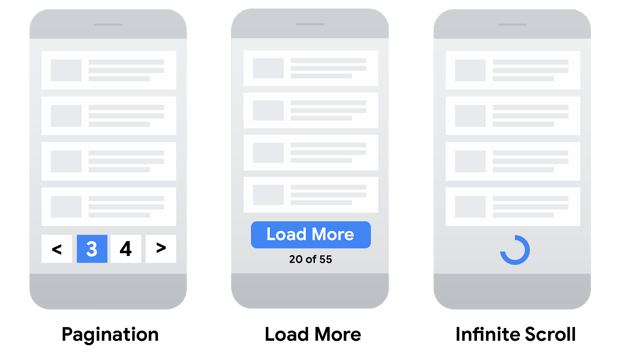
Image Source: Google Search Central
Search engines crawl and index each type of UX pattern differently, so you’ll need to ensure that your website is optimised for search. Luckily, Google has a list of best practices you can follow to make sure its bots can crawl and index your high-quality content.
Ready to sell more with eCommerce SEO?
Improving your visibility on search engines is the first step to unlocking more revenue and greater ROI. eCommerce SEO will help you connect your brand to customers who are looking for your products, then bring them to your website to buy, buy, buy. But to truly nail your eCommerce SEO strategy, you need to work with the best of the best – and that means digital marketing experts who understand how to harness keyword research and search engine optimisation to achieve real revenue results.
Enter OMG.
With a proven track record in helping e-Commerce websites increase SEO rankings, organic traffic, and sales, our Gurus know what it takes to get your business to the top of search engine results. But don’t just take it from us. Claim your free digital site audit today and find out how you can grow your online business faster with an eCommerce SEO campaign.









